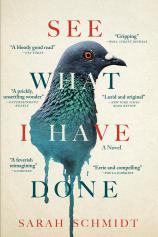See What I Have Done
Review
See What I Have Done
Most Americans have at least a passing familiarity with the infamous 1892 Lizzie Borden murders, if only from the “Lizzie Borden took an axe…” children’s rhyme. However, many people may not know that the Borden home in Fall River, Massachusetts, is now not only a museum but also a bed and breakfast. They also almost certainly are not aware of the full realm of the story, or the cast of characters involved. Sarah Schmidt’s debut novel, SEE WHAT I HAVE DONE, aims to bring the Lizzie Borden story out of obscurity (or a trivial schoolyard rhyme) and give it the subtlety and ambiguity it deserves.
In Schmidt’s version, the events of August 4, 1892 (the day of the murders) and the previous day are recounted from four different narrators. There’s Lizzie herself, of course, a woman who seems to have been emotionally stunted after the death of her mother, who fears her abusive father and is both repulsed and disappointed by her stepmother. There’s Lizzie’s sister Emma, who harbors both artistic aspirations of her own and a long-standing resentment toward what she perceives as their father’s preferential treatment of Lizzie. Emma’s recent departure from the family home seems to have added to Lizzie’s agitation and general unhappiness, as well as to the existing tensions in the home.
"[Schmidt's] intimate portrait and carefully restrained approach ramp up the suspense, making the novel feel contemporary despite its century-old subject matter."
There’s also the family maid, Bridget, an Irish immigrant who desires to leave service for a family whose secrets she’s seen far too closely. But her intentions to depart put her at odds with Mrs. Borden, who is essentially holding her hostage financially. And finally, there’s Benjamin, a stranger from out of town whose chance encounter with Lizzie’s uncle, her dead mother’s brother with an agenda of his own, may upend the conventional understanding of the Borden murders.
SEE WHAT I HAVE DONE is well researched and heavily based on the documented history of the Borden murders. Like the best historical novels, though, it also finds and explores the gray areas in the story, the places not fully covered by the historical record, and that’s where the “real” story resides. The technique of using multiple narrators with overlapping points of view helps contribute to this intricacy. Schmidt’s writing also adds artistry and, surprisingly, moments of beauty to the narrative.
Schmidt focuses especially on the small sounds and tiny domestic details that characterize life in the Borden household. Unlike many historical novels, this book doesn’t provide a lot of atmospheric details about Fall River or late-19th-century New England. Instead, its attention is focused on the interiority of the Borden house, adding to the sense of claustrophobia that pervades the narrative. Thanks to Schmidt’s skillful storytelling, readers will understand why Lizzie has (perhaps) gotten a bit unhinged and why Emma and Bridget are so eager to escape. Her intimate portrait and carefully restrained approach ramp up the suspense, making the novel feel contemporary despite its century-old subject matter.
Reviewed by Norah Piehl on August 18, 2017
See What I Have Done
- Publication Date: June 12, 2018
- Genres: Fiction, Psychological Suspense, Psychological Thriller, Suspense, Thriller
- Paperback: 352 pages
- Publisher: Grove Press
- ISBN-10: 0802128130
- ISBN-13: 9780802128133




